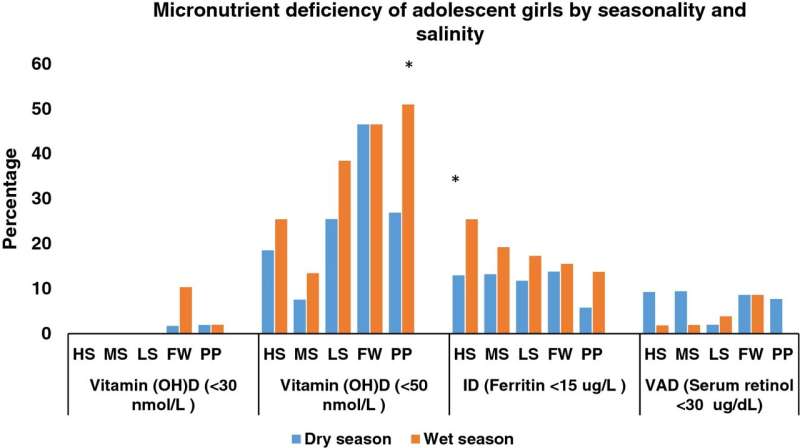This article has been reviewed according to Science X's editorial process and policies. Editors have highlighted the following attributes while ensuring the content's credibility:
fact-checked
peer-reviewed publication
trusted source
proofread
Adolescent girls in Bangladesh at risk of nutritional deficiency, study finds

Adolescent girls in Bangladesh are at risk of nutritional deficiency even if they live in a seafood rich area, a new study has found.
A team headed up by Professor Dave Little carried out research in coastal communities that produce considerable quantities of farmed seafood. They found marked variation in micronutrient deficiencies in vulnerable adolescent girls because the seafood itself varies in nutritional value as does different peoples' access to it.
The target group was chosen because poorly nourished adolescent girls risk intergenerational poor health. The team discovered a prevalence of a deficiency of Vitamin D, the sunshine vitamin, despite the relatively high level of sunshine hours annually in Bangladesh.
The findings could now be used by development agencies to introduce targeted interventions to improve nutrition in vulnerable groups such as adolescent girls. The paper, "Factors affecting the micronutrient status of adolescent girls living in complex agro aquatic ecological zones of Bangladesh," was published in Scientific Reports.
Professor Little said, "Micronutrient deficiency, or hidden hunger, is a massive public health issue leading to high costs to society through people being less healthy and productive than they could be.
"The prevalence of a deficiency of Vitamin D, the sunshine vitamin, occurring in a tropical country may be a surprise to some but suggests how seasonality, human behavior and access to vitamin rich seafood can impact on sufficiency of this micronutrient vital for a healthy immune system.
"This study should support practical initiatives to improve the situation in Bangladesh but also has relevance to other poor coastal zone areas around the world where communities depend on producing nutrient-rich seafood."
The new study comes after Professor Little developed a new tool earlier this year that identifies girls in developing countries who are at risk of nutritional deficiency.
Two cross-sectional surveys in both wet and dry season were carried out in Greater Khulna, Southwest Bangladesh, working with local partners.
The team also worked with human nutritionists from the Rowett Institute, the University of Aberdeen and the Royal Copenhagen University, Denmark, as well as a health economist based at the University of Glasgow.
More information: Gulshan Ara et al, Factors affecting the micronutrient status of adolescent girls living in complex agro-aquatic ecological zones of Bangladesh, Scientific Reports (2023). DOI: 10.1038/s41598-023-33636-8




















